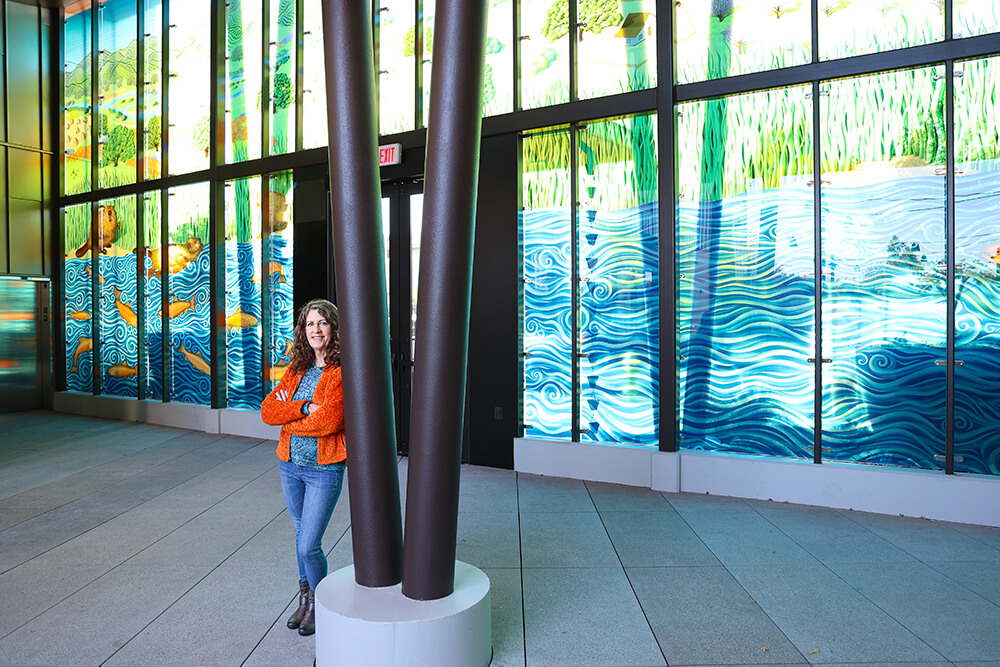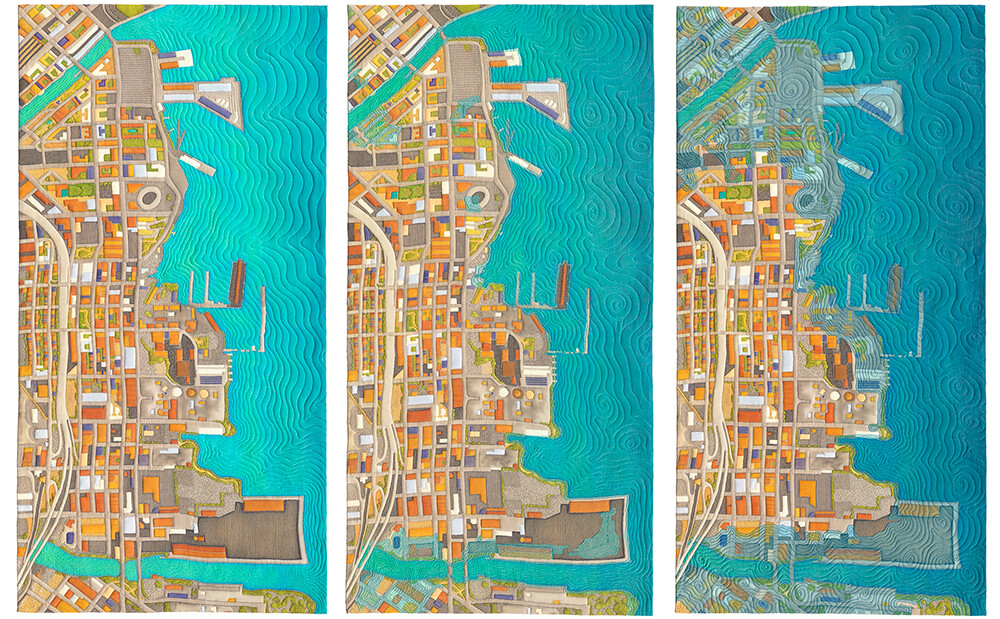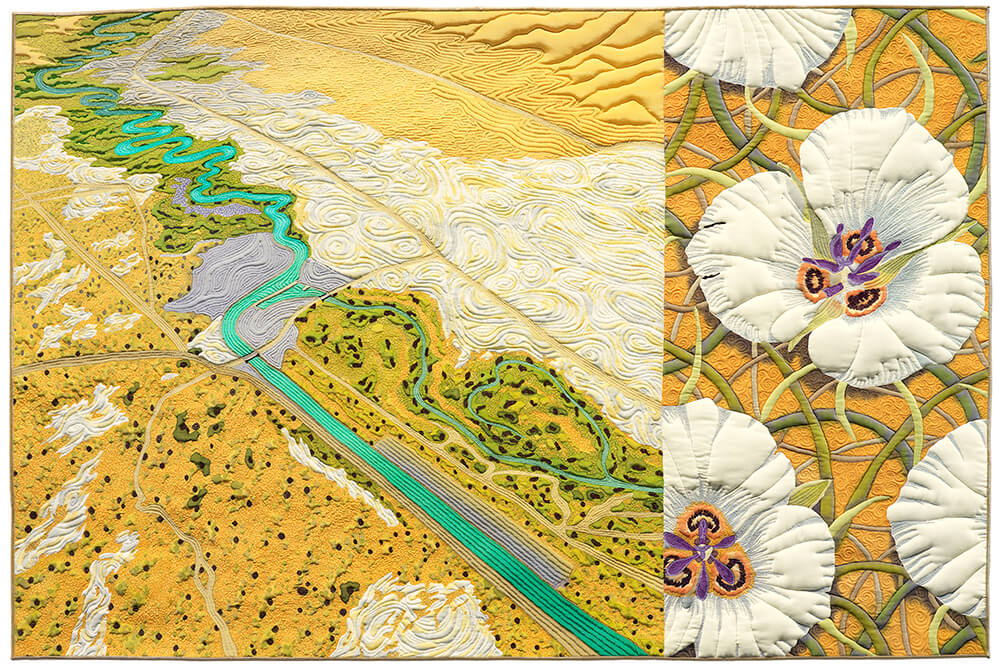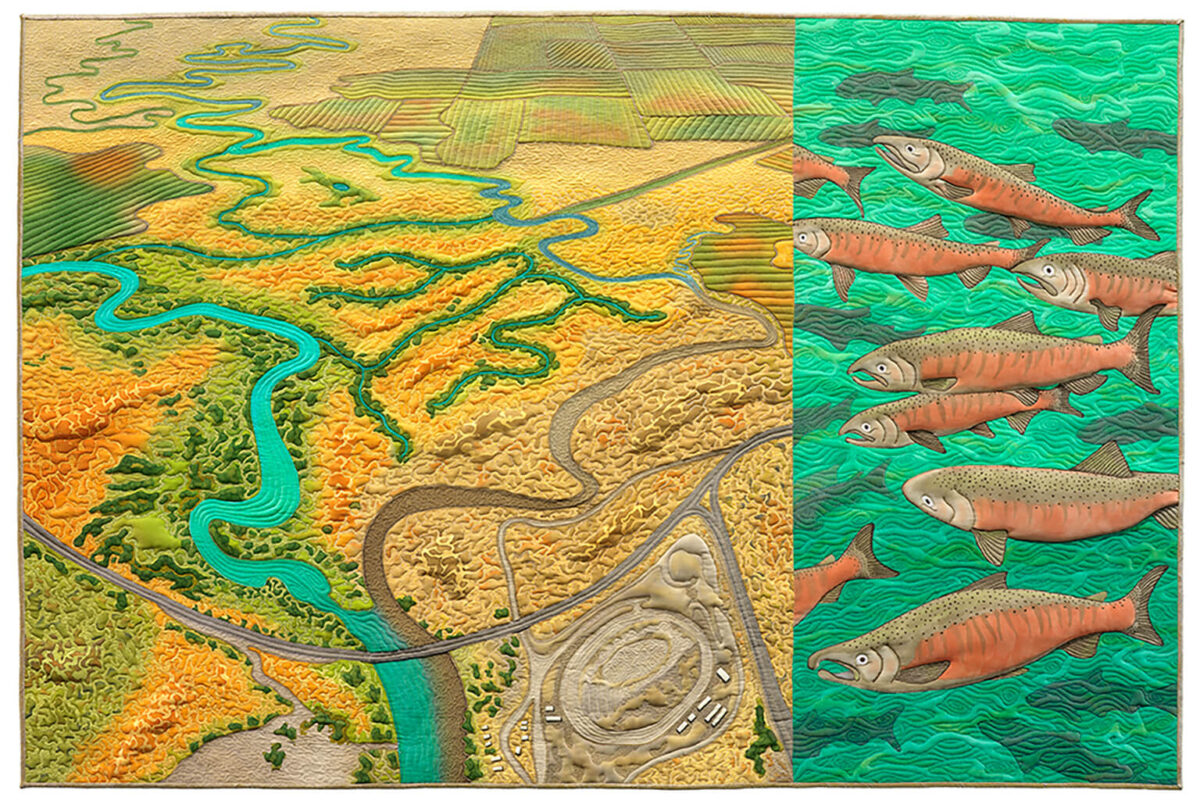Words by Johanna Harlow
There’s a significant amount of abstraction in flying—after all, you’re hurtling through the air in a metal tube at 30,000 feet. The familiar landscape becomes a surreal patchwork of shapes and colors through that plane window, a little like a massive, earthy quilt. Artist Linda Gass captures that feeling in her map-like “stitched paintings,” textile artworks that contemplate water and land-use issues in California and the American West.
Though the Los Altos local also works with glass, Linda has an obvious soft spot for textiles. “They tend to have a comforting feeling to them,” she describes. “We’re used to wrapping ourselves in them. We sleep under them.” Her intricate designs are fashioned by drawing with the sewing machine, guiding the fabric with her hands while controlling the speed of the needle. Averaging a mile’s worth of thread per year, tiny stitches coalesce into textured patterns that reflect the environment—rolling grasslands curve and loop, rows of crops form neat lines, rivers and oceans coil and ripple.

The highlight is the water, not just in texture but in color. Through silk painting, Linda commingles an ever-changing blend of aquamarine and turquoise, cyan and seafoam. She traces her aquatic interest back to her mother. Linda recalls her mom warning that if she didn’t finish her salad, it would rain the next day (a superstition from her mother’s own childhood in stormy Luxembourg). But the threat didn’t carry the same weight in Los Angeles, with its stubborn lack of rain. “We have all these lush green lawns and swimming pools,” Linda remembers thinking. “If it doesn’t rain here, where does our water come from? I had no idea. You know…it comes from the tap!” Later, she was shocked to learn that none of LA’s water came from local sources.
Linda’s enthusiasm for maps also started at a young age. The artist’s face softens with nostalgia when she speaks of hours spent whirling her Rand McNally globe. “I’d play this game where I’d spin the globe, and I’d close my eyes and put my finger on it, just to see where it landed,” she smiles. “Mostly, it landed in the ocean because it’s mostly water. Which also left this big impression on me of how much of our planet is water. It was this process of discovery.”

As a student at Stanford University, Linda cultivated her interest in sustainable living. “I lived in a co-op house where we ate vegetarian,” she notes. “We did recycling, we didn’t use paper napkins with our dinners, we baked our own bread and granola…all those good hippie things!” Today, her advocacy-fueled artwork has been shown at Institute and Museum of California Art, and the Oakland Museum of California. It features in publications like American Craft, Bay Nature and KQED Arts as well as a National Geographic publication on unusual maps. One is even on the cover of an environmental science textbook.

One of Linda’s favorite pieces, included in a solo show at the Museum of Craft and Design, is also a very personal piece. The stitched painting, Severely Burned, reveals the crippling damage of the Rim Fire in the Tuolumne River Watershed through an artistically rendered vegetation burn map. Linda has regularly visited and backpacked in Yosemite National Park dating back to eighth grade, when a week-long class trip taught her to appreciate the area’s ecosystem, from its plants and animals to the glaciers that carved its valley.
And she witnessed the fire in person. “There was this cloud—like one I’d never seen before,” Linda says, recalling the unsettling horizon she saw out the bus window. “It was this cauliflower in the sky. It was not a rain cloud. And the underside of it…the whole cloud was gray. There was no white.” The fire burned so hot it had created its own weather, condensing the moisture from the atmosphere into an unnerving pyrocumulus cloud. Linda vividly recollects the flurry of ash later falling like snowflakes, some crusting on her camera’s zoom lens.

Although her work wades through some harsh realities, Linda takes a surprisingly gentle approach. “I use the lure of beauty to look at the hard environmental issues we face—rather than make artwork that may be more ugly, like the subject matter that I’m dealing with, that people might not want to look at. Or live with.” Visually pleasing images make unappetizing truths a little more palatable. “Otherwise, they might want to stick their heads in the sand because it’s overwhelming.”
It’s an artistic choice that reveals her hopes for the restoration of natural beauty. Catching a bird’s-eye view with Linda reminds us to aim higher and choose to thoughfully steward the planet we all inhabit.


